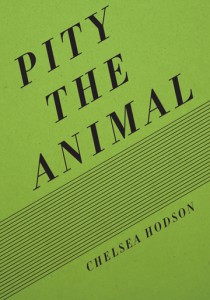
One of the best literary works I’ve encountered this year is Pity the Animal, the new chapbook from Chelsea Hodson. I don’t want to say too much about it: much of its power comes from the way it juxtaposes seemingly unrelated elements: a retrospective of Marina Abramović’s art, scenes from Hodson’s life, economic musings, and considerations of adventure. The way these eventually coalesce is immeasurably powerful; the accumulated effect is devastating, and hits harder than many works ten times its length. I checked in with Hodson via email to learn more about the process behind this book.

Pity the Animal is your second chapbook. Was this written with the format in mind? Was there anything that you’d picked up from your first experience with the format that was applied here?
It was written with the format in mind–I was very conscious of the word count requirement I was given. Unlike some other chapbook formats, the Scout Books used for the Future Tense chapbooks have a set number of 32 pages, so that’s what needed to be filled. Constraints like that are good for my writing, so I enjoyed working toward the right number. The difficult part was making it long enough because as soon as I had enough words, I’d edit and cut a thousand words and have to build it back up. I did that about three times.
I wouldn’t say I necessarily learned from my experience with my first chapbook, I just write short, and that works well for a pocket-sized book.
Throughout Pity the Animal, there are a number of elements that recur: your own experiences, a quote from Joseph Delmont, and the artwork of Marina Abramović. Did one come to mind before the others? How did the three end up coming together?
Trial and error, mostly–I tried to write this essay a year ago and failed. I knew I wanted to write about performance art and the body as an object, but it was missing something. Turns out the missing element was the research on wild animals and window displays. I decided to begin researching wild animals because I felt that might be the missing link between humans and objects–living things often sold as objects.
I also liked the visuals of window displays so I began researching those, and I was surprised to find how much gender played a role in displays from past decades. I loved the scenes the books suggested: putting a rifle in front of a red background, or putting a vacuum in front of a bright yellow background to make women feel happy.
The concepts of the artist and the adventurer are both discussed here; do you identify with one more than the other?
I guess I identify more with the artist, because a lot of my writing is about failing to be the adventurer. I reach the precipice of danger and sit there. Sometimes that’s as much excitement as I can endure. The artist needs some adventure, but my favorite art is about subtlety, nuance, and what gets left out.
Having released a pair of chapbooks, I’m curious: what are your feelings on the form?
I like short work that can stand alone, so I love chapbooks. My current favorites are poetry chapbooks: Dirty City Lions by Shelly Taylor (Horse Less Press) and Orthorexia by Kristin Sanders (dancing girl press). Five minutes at AWP and anyone can see how much good work gets released in small, concentrated chapbook bursts.
As a reader of your Inventory project, I’m curious: does it have any effect on your writing?
Inventory is helpful as a daily exercise, but besides that, it’s pretty separate from my other work. In terms ofPity the Animal though, I think writing Inventory certainly helped define my concept of objects, ownership, as well as objectification. With Inventory, my question is always What does it mean to own this thing? With Pity the Animal, my question was What does it mean to be owned?
Follow Vol. 1 Brooklyn on Twitter, Facebook, Google +, our Tumblr, and sign up for our mailing list.

